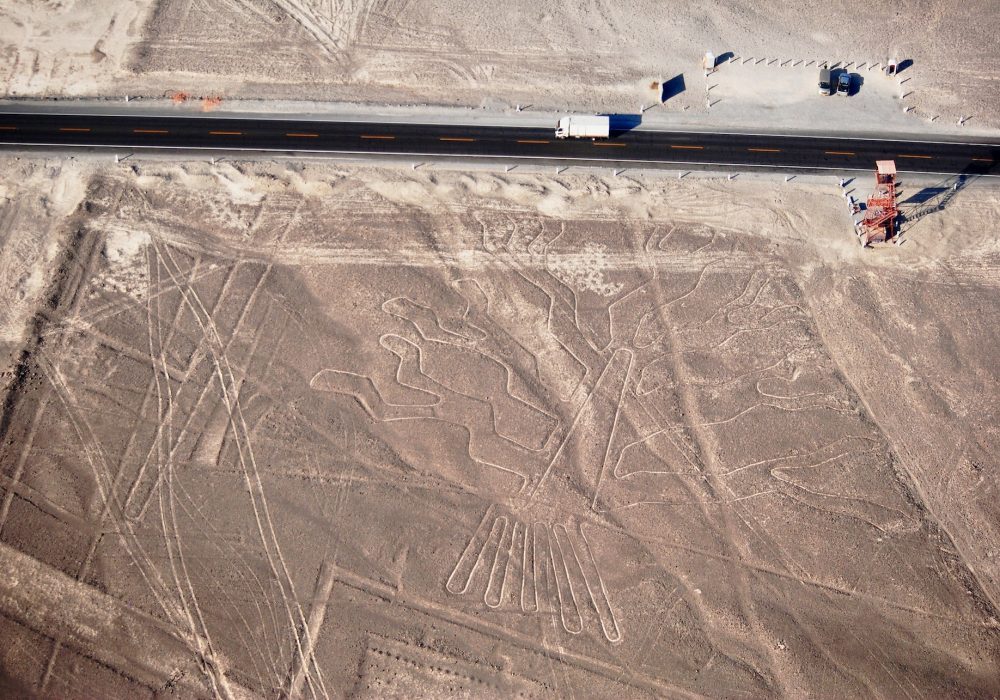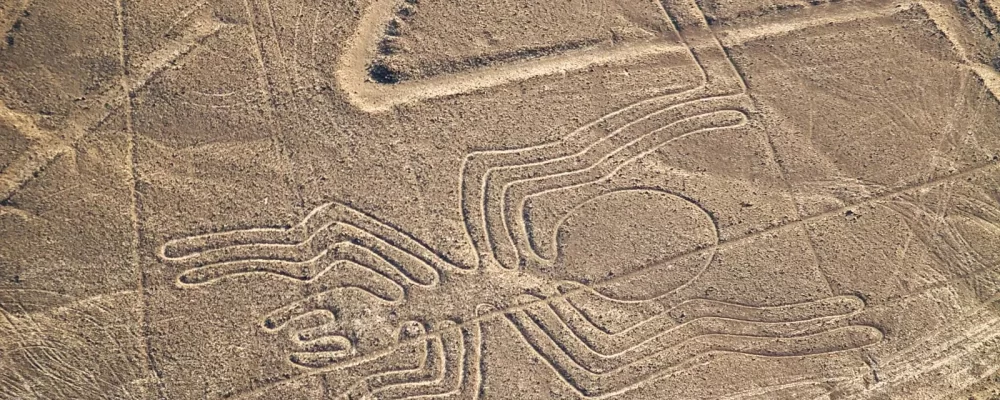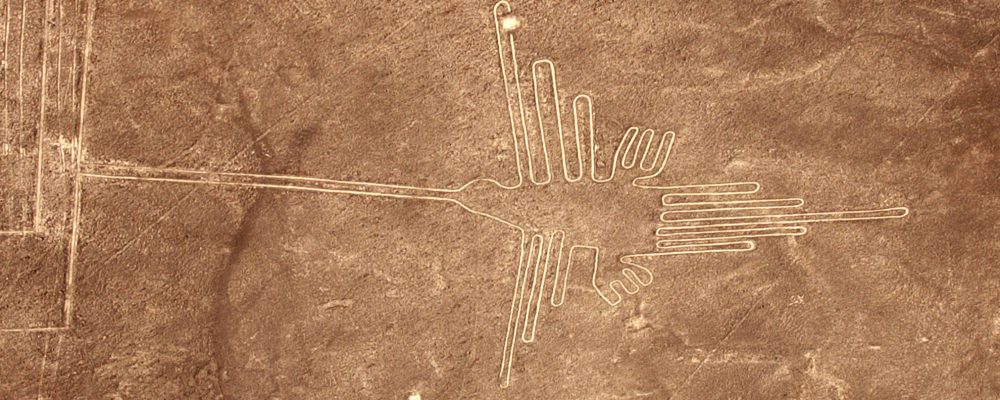Nasca Lines
The Nazca Lines are a series of ancient geoglyphs located in the Nazca Desert of southern Peru. Created by the Nazca culture between 500 BCE and 500 CE, these enormous and intricate designs cover an area of approximately 450 square kilometers. The geoglyphs depict various shapes, including animals, plants, and geometric patterns, and can only be fully appreciated from above. The mystery surrounding the purpose of these lines has fueled numerous theories, ranging from astronomical and religious significance to practical purposes such as irrigation or ritualistic walking paths. The Nazca Lines remain a UNESCO World Heritage Site and a subject of fascination for archaeologists, historians, and curious visitors from around the world, inviting speculation and awe about the ancient civilization that left such an enduring and enigmatic mark on the landscape.

Table of Contents
Overview
The Nasca Lines, also known as the Nazca Lines, are a series of ancient geoglyphs located in the Nazca Desert of southern Peru. These remarkable and mysterious markings cover an area of about 450 square kilometers (170 square miles) on the arid high plateau between the towns of Nasca and Palpa.
Created by removing reddish-brown iron oxide-coated pebbles to reveal the light-colored earth underneath, the Nasca Lines form various designs, including straight lines, geometric shapes, and intricate animal and plant figures. The designs range in size from simple lines a few kilometers long to complex figures that span several kilometers. Some of the most famous geoglyphs include a monkey, a spider, a hummingbird, and a condor, among others.
The Nasca Lines were created by the ancient Nasca people, who inhabited the region from around 200 BCE to 600 CE. The purpose and methods of creating these massive and precise drawings remain subjects of scholarly debate and speculation. Various theories have been proposed, including astronomical alignments, water rituals, and religious or ceremonial purposes.
One prevailing hypothesis is that the Nasca Lines served as an astronomical calendar, helping the Nasca people align their agricultural and ceremonial activities with celestial events such as solstices and equinoxes. Others suggest that the lines had religious significance, possibly related to water worship or as pathways for ritual processions.
The Nasca Lines gained international attention in the 20th century when commercial airlines began flying over the region, allowing passengers to see the enormous geoglyphs from above. In 1994, the Nasca Lines were designated a UNESCO World Heritage Site in recognition of their cultural and historical significance. However, the fragile desert environment and the increasing human activity in the area have raised concerns about the preservation of these ancient markings.
Despite decades of research, many questions about the Nasca Lines remain unanswered, contributing to their enigmatic and captivating nature. Ongoing studies using advanced technologies such as satellite imagery and geospatial analysis continue to shed light on the purpose and cultural context of these intriguing ancient geoglyphs
History

The Nasca Lines, also known as the Nazca Lines, are a series of ancient geoglyphs located in the Nazca Desert of southern Peru. These enormous drawings are etched into the high, arid plateau, covering an area of about 450 square kilometers (174 square miles). The Nasca Lines are renowned for their sheer size, intricate designs, and the mystery surrounding their purpose.
The geoglyphs were created by the Nasca people, who lived in the region from around 200 BCE to 600 CE. The Nasca civilization, a pre-Inca society, is known for its advanced pottery, textiles, and extensive irrigation systems. However, it is the Nasca Lines that have captured the imagination of researchers and archaeologists.
The Nasca Lines consist of various designs, including geometric shapes, animals, and human figures. Some of the most famous figures include a spider, a monkey, a hummingbird, and a condor. The precision and scale of these drawings are remarkable, with some stretching over 1,000 feet (300 meters) in length. The geoglyphs were created by removing the reddish-brown iron oxide-coated pebbles that cover the surface of the Nazca Desert to reveal the light-colored earth underneath.
One of the enduring mysteries surrounding the Nasca Lines is the purpose behind their creation. Various theories have been proposed, ranging from religious and astronomical significance to water rituals and agricultural practices. Some researchers believe that the Nasca people used the lines as pathways for ceremonial processions, while others suggest that they were connected to the Nasca’s beliefs in deities or water sources.
In recent years, researchers have explored the possibility that the Nasca Lines served as a form of irrigation or water management system. This theory suggests that the lines were connected to underground aquifers and used to mark the flow of water for agricultural purposes in this arid region.
Despite the many theories, the exact purpose of the Nasca Lines remains speculative, and the mystery surrounding their creation adds to their allure. The Nasca Lines were designated as a UNESCO World Heritage Site in 1994, recognizing their cultural significance and the need for their preservation. In recent times, the lines have faced threats from illegal land invasions and climate change, highlighting the importance of ongoing efforts to protect and study these ancient wonders.
Things to do
The Nasca Lines, located in the arid coastal plain of Peru, are a series of ancient geoglyphs that date back to the Nasca civilization, which flourished from around 200 BCE to 600 CE. These massive drawings, etched into the desert floor, depict various animals, plants, and geometric shapes. The Nasca Lines are a UNESCO World Heritage Site and a fascinating destination for those interested in archaeology, history, and mysterious ancient cultures. Here are some things to do when visiting the
Nasca Lines:
Aerial Tours: One of the most popular ways to experience the Nasca Lines is by taking a scenic flight over the area. Several tour operators in the town of Nasca offer small aircraft flights that provide a bird’s-eye view of the geoglyphs. The best time for these flights is in the morning when the sunlight casts shadows, making the lines more visible.
Mirador Tower: For those who prefer to stay on the ground, the Mirador Tower offers a panoramic view of three of the most famous Nasca figures – the tree, the hands, and the lizard. It’s an excellent vantage point for appreciating the scale and precision of these ancient drawings.
Maria Reiche Museum: Named after the German mathematician and archaeologist who dedicated much of her life to studying the Nasca Lines, the Maria Reiche Museum provides insights into the history, theories, and preservation efforts related to the geoglyphs. Visitors can learn about the various figures and the cultural significance of the lines.
Cantalloc Aqueducts: Just a short drive from Nasca, the Cantalloc Aqueducts are a remarkable ancient engineering feat. These underground channels were built by the Nasca people to bring water from underground sources to their agricultural fields. Exploring the aqueducts is an opportunity to appreciate the advanced knowledge and skills of the Nasca civilization.
Chauchilla Cemetery: For a glimpse into Nasca burial practices, a visit to Chauchilla Cemetery is recommended. This ancient burial site features well-preserved mummies and artifacts, providing valuable insights into the rituals and customs of the Nasca people.
Archaeological Sites: Explore other Nasca archaeological sites, such as Cahuachi, believed to be a major religious and administrative center. The site features pyramid-like structures and plazas, offering a deeper understanding of Nasca society.
Local Cuisine: Nasca offers a chance to savor traditional Peruvian cuisine. Local restaurants serve dishes like ceviche, lomo saltado, and rocoto relleno. Don’t forget to try Peruvian desserts like suspiro a la limeña or picarones.
Remember to check the local regulations and conservation efforts to ensure a responsible and sustainable visit to the Nasca Lines, as preservation is crucial to maintaining these ancient wonders for future generations.
Hotels
As of my last knowledge update in January 2022, I don’t have specific information about individual hotels in Nasca, Peru. However, I can provide you with a general overview of what you might expect when looking for a hotel in Nasca.
Nasca, also spelled Nazca, is a town located in the Nazca Desert of southern Peru. It is famous for the Nazca Lines, a series of ancient geoglyphs etched into the desert floor. Due to its historical and archaeological significance, Nasca attracts tourists from around the world.
When searching for a hotel in Nasca, you can expect a range of options catering to different budgets and preferences. Here are some features you might find in hotels in Nasca:
Accommodation Types:
Nasca offers a variety of accommodations, including budget hostels, mid-range hotels, and possibly a few luxury options.
Some hotels might have traditional Peruvian architecture or a modern design, providing different atmospheres for guests.
Amenities:
Depending on the hotel’s category, amenities may include free Wi-Fi, air conditioning, swimming pools, and parking facilities.
Given the arid climate of the region, some hotels might offer refreshing outdoor spaces or gardens.
Location:
The proximity of the hotel to the Nazca Lines or the town center may vary. Some hotels could be situated in the heart of Nasca, providing easy access to local attractions, restaurants, and markets.
Tour Services:
Given the tourist attraction of the Nazca Lines, many hotels might offer tour services or assistance in arranging flights over the lines.
Cuisine:
On-site restaurants or nearby dining options could offer a taste of local Peruvian cuisine, featuring dishes with traditional flavors and ingredients.
Cultural Experience:
Some hotels might incorporate local cultural elements into their design or provide information about the Nazca culture and history.
Safety and Security:
Most hotels prioritize the safety and security of their guests, and Nasca is generally considered a safe destination for tourists.
Before booking a hotel, it’s advisable to read recent reviews from other travelers to get a sense of the current quality and service. Additionally, check for any updates or changes in the region’s travel conditions and safety recommendations.
Restaurants
As of my last knowledge update in January 2022, I don’t have specific information about individual restaurants in Nasca, Peru. However, I can provide you with some general information about the culinary scene in Nasca, and you may want to verify the details with more recent sources.
Nasca is a town in southern Peru, known for the famous Nazca Lines, an archaeological and historical wonder. While Nasca may not be as renowned for its culinary scene as some other cities in Peru, it still offers a variety of dining options that showcase local flavors and ingredients.
Local Cuisine:
Nasca, like many other Peruvian cities, likely offers a range of local dishes. Peruvian cuisine is diverse, with influences from indigenous, Spanish, African, and Asian culinary traditions. Look out for traditional dishes such as ceviche (marinated raw fish or seafood), lomo saltado (stir-fried beef), and aji de gallina (shredded chicken in a spicy yellow pepper sauce).
Market Stalls:
Exploring local markets can be a delightful culinary experience. You may find street vendors and market stalls selling snacks and small meals. Empanadas, anticuchos (grilled skewers, often with marinated meat), and fresh fruits are common street food options.
Restaurants Near Nazca Lines:
As Nasca is a popular destination due to the Nazca Lines, you might find restaurants and cafes near the archaeological site catering to tourists. These establishments may offer a mix of local and international cuisine to suit different tastes.
Pisco Tasting:
Pisco, a grape brandy, is a significant part of Peruvian culture. You may find bars or restaurants in Nasca offering Pisco tasting experiences. The region is known for its Pisco production, and trying different varieties can be a unique culinary experience.
Local Bakeries:
Don’t forget to explore local bakeries for a taste of traditional Peruvian pastries and bread. Pan chuta, a sweet bread often enjoyed during festivals, might be something to look out for.
When looking for specific restaurant recommendations, it’s a good idea to check recent reviews on travel websites, social media platforms, or consult with locals for up-to-date information. Keep in mind that the culinary scene in any city can evolve, and new establishments may have opened since my last update in January 2022.
Tour Packages
Travel Tips

Visiting the Nasca Lines in Peru is a fascinating experience, as these ancient geoglyphs etched into the desert floor are a UNESCO World Heritage Site and a testament to the creativity of the ancient Nasca culture. Here are some travel tips to enhance your visit to the Nasca Lines:
Best Time to Visit:
The Nasca region has a desert climate, so it’s advisable to visit during the dry season (from May to October) to avoid rain and maximize visibility.
Getting There:
The nearest major city is Lima. You can either take a bus (approximately 7 hours) or a domestic flight to the Nasca region.
Flight Over the Lines:
The best way to appreciate the Nasca Lines is from the air. Several companies offer small aircraft flights that provide stunning aerial views of the geoglyphs. Ensure the company you choose follows safety regulations.
Altitude Considerations:
Nasca is at a relatively low altitude, but if you’re coming from higher altitudes, it’s a good idea to acclimatize yourself to avoid altitude sickness.
Book in Advance:
Flights over the Nasca Lines can be popular, so it’s advisable to book your tour in advance, especially during the high tourist season.
Bring Essentials:
Sunscreen, a hat, and sunglasses are essential, as the desert sun can be intense. Also, carry a refillable water bottle to stay hydrated.
Protective Clothing:
Wear comfortable clothing and closed-toe shoes, especially if you plan to explore the surrounding areas.
Photography Tips:
If you’re planning to take photos from the plane, choose a seat on the side that will provide the best views of the Nasca Lines. Consider bringing a camera with a good zoom lens.
Guided Tours:
Consider joining a guided tour. Knowledgeable guides can provide historical context and point out specific figures in the geoglyphs that might be hard to spot from the air.
Respect the Site:
The Nasca Lines are fragile, and walking on them is strictly prohibited to preserve their integrity. Follow all guidelines and regulations to ensure the preservation of this cultural treasure.
Visit the Maria Reiche Museum:
Maria Reiche, a German mathematician and archaeologist, dedicated her life to studying the Nasca Lines. The Maria Reiche Museum in Nasca pays tribute to her work and provides additional insights into the geoglyphs.
Local Cuisine:
Explore local cuisine in Nasca. The region is known for dishes like cuy (guinea pig) and other traditional Peruvian foods.
By keeping these tips in mind, you can make the most of your visit to the Nasca Lines and appreciate the mystery and beauty of these ancient creations.
FAQ´s
Frequently Asked Questions (FAQ) for Visiting Lake Titicaca
The Nasca Lines are a series of ancient geoglyphs located in the Nazca Desert of southern Peru. These massive designs, etched into the ground, include various geometric shapes, animals, and plants. They are believed to have been created by the Nazca people between 500 BCE and 500 CE.
The Nasca Lines are accessible from the town of Nasca. Visitors typically arrive by bus or car from cities like Lima or Arequipa. There is also a small airport in Nasca where you can take a flight over the lines for an aerial view.
No, walking on the Nasca Lines is strictly prohibited. The delicate nature of the lines means that any contact can cause irreversible damage. Visitors can view the lines from designated platforms or take a flight over them for a comprehensive experience.
The purpose of the Nasca Lines remains a mystery, but theories suggest religious or astronomical significance. Some believe they were used for ceremonial or ritualistic purposes, while others think they served as an astronomical calendar.
Yes, flying over the Nasca Lines is generally considered safe. However, it’s crucial to choose a reputable and licensed air operator. Ensure that the aircraft is well-maintained and the pilot is experienced.
Photography is allowed, but the use of drones is strictly prohibited. Additionally, some areas may have specific rules to protect the lines, so it’s essential to follow the guidance of your tour guide or site officials.
The Nasca Lines can be visited year-round, but the best time is during the dry season, from May to November, when the weather is more stable. Rain can obscure the lines, and the scorching sun during the peak of summer can create harsh lighting conditions.
Yes, guided tours are available in Nasca, and they are highly recommended. Knowledgeable guides can provide historical and cultural context to enhance your understanding of the Nasca Lines.
Apart from the Nasca Lines, the region offers other archaeological sites, museums, and the Chauchilla Cemetery, which contains well-preserved mummies.
Yes, Nasca has a range of accommodations, from budget hostels to more luxurious hotels, making it suitable for various travelers.
Remember to check for any updated information or regulations before planning your visit, as circumstances can change. Enjoy your exploration of the fascinating Nasca Lines!




